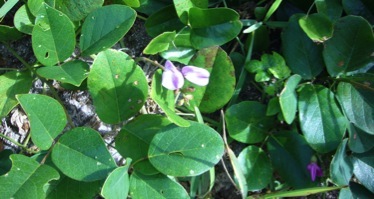Canavalia maritima, Rosea, Beach Bean
It’s the tank of beans: Three inches long, an inch wide and very thick. And with good reason, it lives near the sea.
Canavalia maritima (aka rosea) gets mixed reviews, eaten for a long time and listed as toxic. The adult beans are definitely to be avoided but the young seeds are being eaten by humans somewhere now. Here is what Prof. Daniel Austin has to say about it in his huge book “Florida Ethnobotany:”
“Ignorance, they say, is bliss. So, my students and I were certainly blissful for years. At one time I had an anthropology student who was interested in plants used by people. She convinced me that the seeds of the bay bean [Canavalia maritima] were edible by gathering a handful in the field, cracking the seed coats with her teeth, and eating the contents. I tried them, and they were tasty — nutty and sweet. Then, I read about the alkaloids and proteins found in the seeds, and discovered that they were considered by many to be toxic. I quit eating them and stopped showing students how to eat them.
“However, there is a long history of people eating many of the species in the Canavalia. For example C. ensiformis is grown as a vegetable in tropical areas. The young pods are sliced and eaten like French Beans… C. gladiata seeds are edible, and its foliage is used for fodder.
“More recent studies of chemicals have established that… Canavalia contains cyanides, complex proteins, and alkaloids. … Yet other studies have confirmed what humans discovered thousands of years ago — processing the seeds renders them edible….”
Austin goes on to say there is no record of local natives using the C. Maritima for food, and among Caribbean people it is viewed as a medicine.
Perhaps C. maritima should be put in the same category as its close look alike, the Ipomoea pes-caprae, edible in small amounts in an emergency. When the two plants are in blossom it is easy to tell them apart. C. maritima has a pea blossom (wings and keel) I. pes-caprae, a morning glory blossom, fused petals. When not in blossom the C. maritima has alternating leaves of three, whereas the I. pes-caprae has single alternating leaves. Mature C. maritima beans are toxic, which is just as well. I have found the pods while out canoeing or kayaking and they are tough to open.
Canavalia (kan-uh-VAY-lee-uh) is the latinized version of the native Malabar name for the plant. Maritima (mar-ih-TEE-muh) of or near the ocean.
Green Deane’s “Itemized” Plant Profile
IDENTIFICATION: Vine to 30 feet or more, creeping along the sand. Leaves alternating with three thick leaflets to five inches long, oval to oblong, blunt at tip. Bean-shaped flower. Fruit a dry pod to six inches long, an inch or less wide, flattened.
TIME OF YEAR: Summer and fall
ENVIRONMENT: Beaches above the high-tide line.
METHOD OF PREPARATION: Young seeds boiled throughly.




Hi. I’ve been trying to find information about a weed that looks just like green beans. It seems to be attracting a lot of bees. They do seem do get quite long too, like longer than typical green beans. I am not sure what they are. Also wondering if they’re edible…since I have 3 young children who think they are green beans.
Where is this? Is it a wild plant or an escaped cultivate one such as the Yard Long Bean?
I have some Beach Bean growing in an empty lot next to me. I never really noticed the bean pods until recently when playing with my dog and daughter. I want to grow some myself so I can harvest the young pods for our own consumption. Hey, why not, right? Oh, well, except the cyanide…
How definitive are the studies that show cyanide present, and most importantly is it a sufficient amount to be a problem in a normal serving?
I have eaten the seeds and there is no evidence of any milky sap/exude or bitter taste typical of alkaloids & most poisonous plants.
There taste would seem to indicate they are very palatable, even raw.
Very interested in some definitive data on this if you have any. Thank you.
They do contain a moderate amount of cyanide. The immature beans (when you open the pod, the beans are white and soft-ish) don’t contain very much, but the mature beans (darker and firm or hard) have more. So eating a pod full of immature beans would be ok, but a pod full of mature ones could harm a child. However, proper bean preperation will leach out the poison. Remove the mature beans from the pod; soak them overnight in room temperature water; Drain the water (don’t use) and rinse the beans with more water; Put the beans into a saucepan and add five times more water than beans (by volume); Bring to a slow boil or a fast simmer; simmer for an hour; Drain off any excess water. Add spices to taste. Note: Immature beans do not need to be soaked overnight, as they are already soft and do not contain very much toxin to be leached off.
This is a guideline and you should try a small amount, at first, in case you have a sensitivity or allergy.
Wood furnishings possesses something very all natural concerning it.
There is this feeling of comfort, of attributes
and of beauty that may be be located in wood furnishings.
Hardwood is born from the planet.
Hi! Do the leaves/flowers contain cyanide as well? I’ve read reports of many people making tea from them and I wanted to try it.